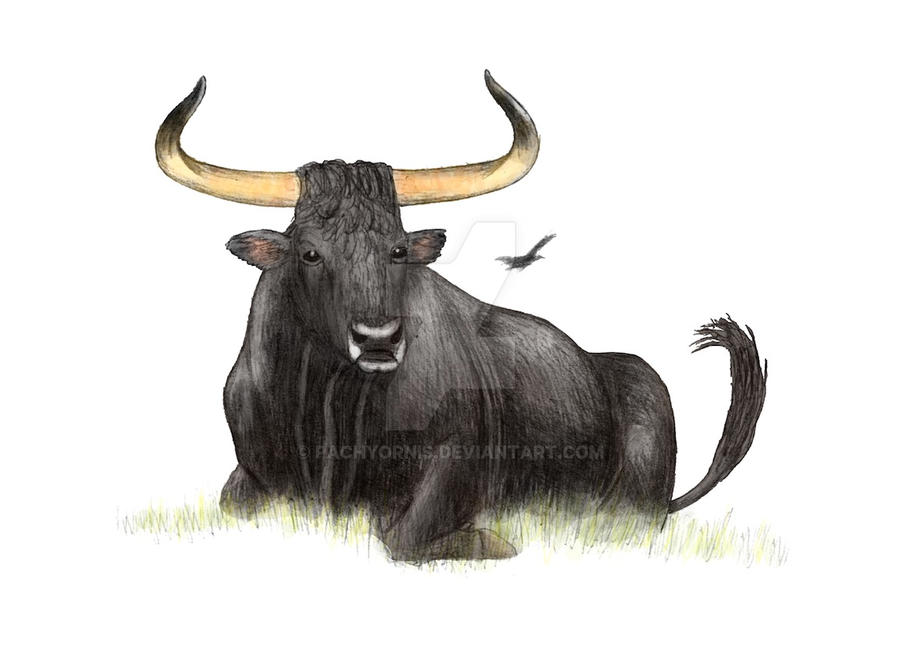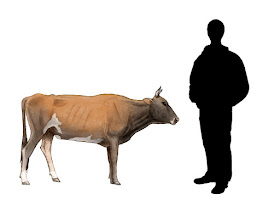Hybridization is very common in the animal kingdom and takes place everywhere closely related species meet each other. There are plenty of examples where hybridization played a role in speciation, not only in amphibians and fish but also mammals, including us humans. For a post on hybridization, go here.
In recent years, it has been suggested that the wisent is a species hybrid of aurochs and steppe bison because the wisent clusters with domestic cattle on mitochondrial level. For details, go here. This theory has recently been questioned by a 2016 paper that suggests the affiliation of wisent and cattle mitogenomes are more likely a result of incomplete lineage sorting. It also suggests an early split from the steppe bison, from which it differs in head orientation associated with food choice. While the American bison and Steppe bison have a lower head orientation than the wisent as they are primarly grazers, the wisent has a higher head orientation and is a mixed feeder, which is probably the result of living in a more forested habitat [1]. A 2017 study indeed suggests that Bison schoetensacki was the immediate ancestor of the wisent [2].
However, the wisent does show signs of admixture with Bos in its nuclear genome [3]. The study compared both modern and pre-bottleneck wisents to cattle and the 8.000 year old British aurochs with the fully resolved genome and found signs of interbreeding with domestic cattle. The authors also emphasize that it is possible that these genes are not from domestic cattle but from aurochs closer to domestic cattle than the British aurochs. Either domestic cattle or aurochs or both left their track in the genome of the wisent. However, the very small portion of Bos DNA suggests that this introgression did not happen in recent times. Hybridization may indeed explain the diverging horn shapes sometimes found in wisent, like in this individual at Hellabrunn Zoo I photographed in 2011:

It is important to note though that wisent and cattle do not interbreed spontaneously. Not a single case of hybridization between both species in the wild has been reported even if they share the same habitat [4]. All wisent-cattle hybrids were created in human custody. However, it might have happened that domestic cattle genes found their way into the wisent genome over those hybrids. If they escaped and joined wild wisent herds, they might have been more likely to interbreed than pure cattle.
Another possibility would be that both species interbred more easily than today when aurochs arrived in Europe during the middle Pleistocene and later further diverged due to the so-called Wallace effect or reinforcement. In this case, hybrids between aurochs and wisent would have a lower evolutive fitness than pure individuals, thus decreasing the likelihood that both species interbreed. This is just a thought-experiment of mine.
Another possibility if aurochs and wisent indeed interbred in the past could be that the influence from wisents helped the newly arriving aurochs, which migrated from subtropical areas, to cope with the European climate. I would not be surprised if the curly hair on the forehead that can also extend to the entire neck, dewlap and shoulders which are found in taurine cattle and European aurochs, were in fact vestiges of hybridization with wisents, as those curly hair is very opulent in bison but completely absent in zebus and other Bos cattle.
Because of the fact that bison and Bos cattle can interbreed, some authors tend to list them all as one genus Bosin recent years. I tend not to. There are no objective measures to determine what is one genus or more than one, it entirely subjective just as all systematic ranks. Hybrids between genera are not that uncommon, for example in chicken, whales (see “Wholphin”) and there is even one case in elephants (see “Motty”). Paleonotological evidence suggests that bison descend from Leptobos, and genetic evidence also suggests that yaks are in fact part of the bison branch and might descend from Leptobos as well. Bos, on the other hand, might descend from Pelorovis. In this case it could well be that all Leptobos and Pelorovis species could interbreed with cattle and bison if they were alive today. Thus they would have to be included into Bos as well, making it an extremely variable super-genus based solely on the fact that they can interbred. And, to be consequent, other genera would have to be lumped as well. Pseudorca and Tursiops and all related genera would have to be listed as one genus, and one might even go that far to synonymize Loxodonta with Elephas. The ability to interbreed alone might not be the best criterion for synonymizing genera, especially as it is gradual from fully infertile offspring to only one sex being fertile to fully fertile offspring.
Literature
[1] Massilani et al.: Past climate changes, population dynamics and the origin of Bison in Europe. 2016.
[2] Palacio et al.: Genome data on the extinct Bison schoetensacki establish it as a sister species of the extant European bison. 2017.
[3] Wecek et al.: Complex admixture preceded and followed the extinction of wisent in the wild
[4] Vera: Do European bison and domestic cattle cross spontaneously? 2002. Vakblad Natuurbeheer






